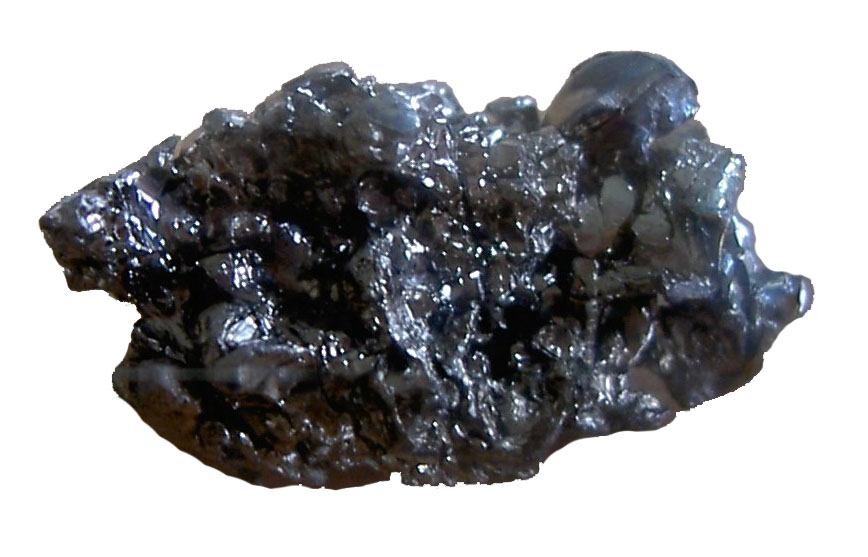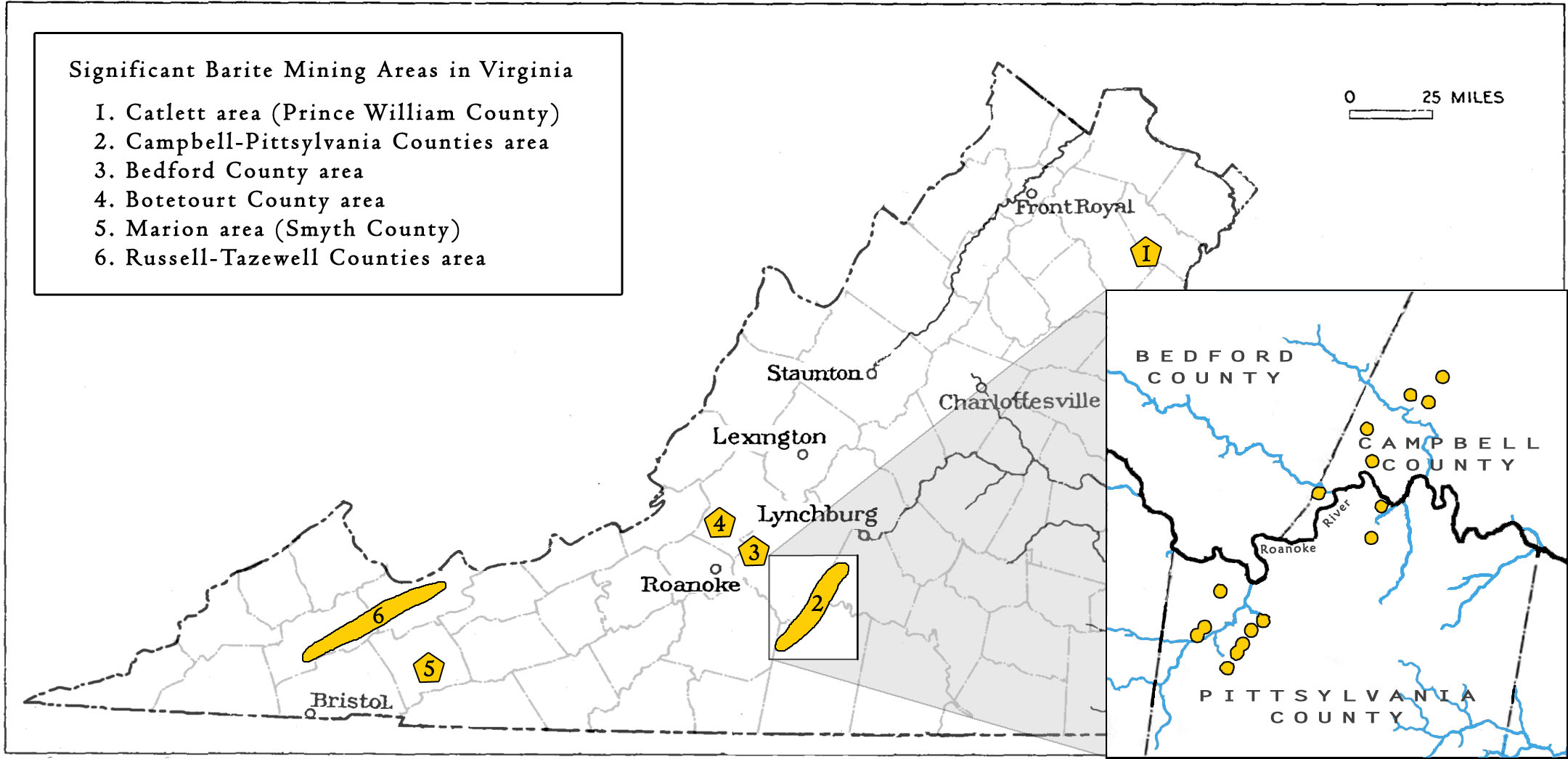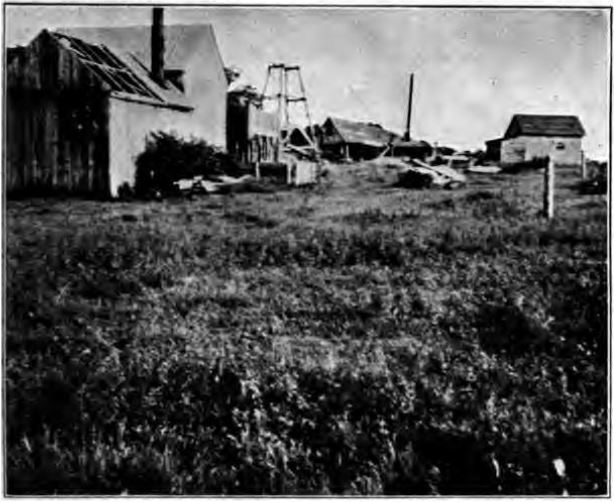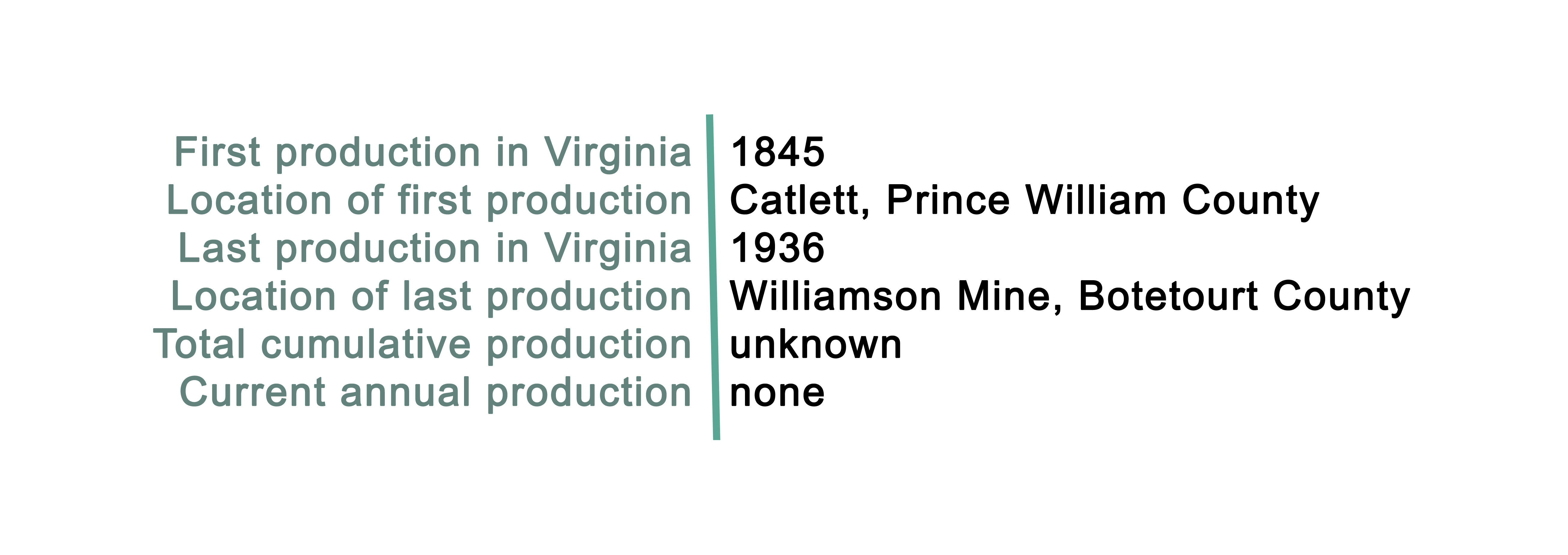Characteristics of Barite
Barite (baryte) is a mineral composed of barium sulfate (BaSO4). The mineral barite (BaSO4) is the principal ore for the element barium, which has the chemical symbol Ba. The heavy metal barium is silvery, soft, highly reactive, and does not occur in its elementary form in nature. Barium is commonly found within the mineral barite, bound with sulfur and oxygen. Barite occurs as pale yellow or colorless tabular crystals. The exploration for and development of petroleum and natural gas resources accounts for nearly 95 percent of domestic consumption and about 90 percent of global consumption of barite.

Barite mineral crystals.
Image courtesy of Carles Millan.

| Mineral Name | Chemical Formula | Specific Gravity | Ba % |
|---|---|---|---|
| Barite | BaSO4 | 4.48 gm/cc | 58.84 |
| Witherite | BaCO3 | 4.30 gm/cc | 69.591 |
Table 1: Minerals containing the element Barium
Uses of Barite
Barite is considered a "critical mineral" in domestic metallurgical applications that serve energy technologies (Fortier and others, 2018). The mineral barite is a key component in drilling mud, which is used in the oil and gas industry to prevent blow-outs, where high pressures at depth can force material upwards through the drill shaft. Mined barite is ground to a fine powder and mixed with mud to make a heavy slurry. The mud is then poured down the drill hole creating a plug around and above the drill bit. Because barite is soft, it does not damage the drill bit, but due to its high specific gravity, barite effectively counteracts upward pressure, confining the oil or gas and reducing the likelihood of a blow-out.
Elemental barium is an additive in optical glass, ceramic glazes, and other products. Barite is used as a weighing agent in a variety of other applications, including paper, brakes, and even playing cards. It is commonly used in the production of paints, rubber, and as a filler or to improve brilliance and clarity. The medical industry uses barite for radiation shielding, or to increase contrast in radiographs.

Barium in its elementary form - a toxic heavy metal.
Barite Geology
Barite deposits may form in several ways. As a bedded sedimentary deposit, barite forms as marine sediment and biological activity bind barium into layered deposits on the ocean floor. Such sediments lithify into shale or mudstone with barite occurring in nodular, rosette, bedded, or massive forms. Barite may also occurs in cavities or veins, forming as permeable rocks permit high-temperature fluid flow and associated minerals grow by precipitation. Barite can form extensively along faults and breccia zones, or may be confined to smaller and irregular cavities within rocks. Barite deposits can form as a result of the weathering of cavity-fill barite mineralization within carbonate host rocks. When rocks rich in barite weather, barite can accumulate as residual deposits
| Mineral System | Deposit Type | Geologic Provinces |
|---|---|---|
| Basin brine | Replacement and bedded barite | Valley and Ridge |
| Basin brine | Strata-bound replacement, veins, breccia fill | Piedmont, Blue Ridge |
Table 2: Prospective barite mineral systems, deposit types (Hofstra and Kreiner, 2020), and geologic provinces in Virginia
Barite in Industry
The United States does not maintain a supply of barite in the National Defense Stockpile and is import reliant with approximately 87 percent imported from China, India, Morocco, and Mexico. Economic deposits of barite are relatively common and distributed across the world. Production within the United States is primarily from Nevada and Georgia. Smaller deposits are known in other states across the country.
Barite has been mined in Virginia for many years and has been identified across the state in many counties. Commercial production has been limited to only a handful mining areas. The first mining for barite in Virginia occurred as early as 1845 in Prince William County near the town of Catlett. Following the Civil War, several other mines opened and were able to produce barite on a commercial scale. Valley and Ridge rocks have historically been an important source of barite in Virginia.

Map of significant areas for barite mining in Virginia.
Prince William County

Barite Mining Catlett, Virginia
Photo from Watson, 1907.
Barite was first mined in Virginia in Prince William County near the town of Catlett. Here, mining occurred on and off between 1845 and 1903. The barite deposits were identified within a fracture zone of limestone breccia and sandy shales with barite-filled fractures (Watson, 1907). Open cuts and three shafts reaching a depth of 108 feet, a grinding mill, and a crushing house comprise the old mining operations (Watson, 1907).
Campbell/Pittsylvania Counties
Several mines are scattered in a 30 mile-long belt through Campbell, eastern Bedford, and Pittsylvania Counties, where barite had been mined in the residuum since at least the 1870s (Watson 1907; Edmundson, 1938). Barite here is associated with marble and can be identified surficially by a distinctive red, iron and manganese-rich residual clay (Edmundson, 1938).
Bedford County
Barite was first mined in Bedford County in 1866, but the results were minor and mining likely lasted only a few years (Edmundson, 1938). Two mines are located just west of the town of Bedford, the Saxton and McMillan mines. Shallow cuts and trenches hundreds of feet long and up to 40 feet deep were used to prospect for barite. Vertical shafts were also dug. During its original operation, a small quantity of barite was extracted and shipped for use. The mines reopened briefly in 1906, when a 30 inch-wide barite vein was discovered in the bedrock.
Botetourt County
One of the earliest barite mining operations in Virginia occurred in Botetourt County. In 1850, several prospect pits, an open cut, and a shaft was dug (later named the Williamson Mine) into Conococheague limestone residuum just north of Fincastle. Several other sites were prospected and small quantities of barite were extracted until mining operations ceased in 1906. Operations commenced again in 1934, when prospecting led to the discovery of additional barite deposits near Fincastle. During the final years of production (1935-1936) in this area, between 7-9 thousand tons of barite are reported to have been extracted from four deposits. Although operations were commercial, these deposits were relatively small in size and field examinations indicated that most of the residual and replacement barite had been mined out by 1936.
Russell/Tazewell and Smyth Counties
Barite mining in southwestern Virginia began around 1875 and became a commercial source by 1880. There are two main mining areas, one in Russell and Tazewell Counties and one in Smyth County (Watson, 1907). In both areas, barite occurs with limonite, calcite, siderite, and occasional fluorite as stratified replacements in limestone and dolostone of the Ordovician Beekmantown Formation. Loose barite nodules may also be found in the residuum.
A primary source for barite in Virginia was the northeast-trending belt of Beekmantown rocks following the Clinch River in Russell and Tazewell Counties. This 35 mile stretch of carbonates is the location of many mines and prospects which produced barite ore between 1880 and 1908. Several mills were constructed along this belt and crushed barite for shipment.
The Leonard, Hubbard, and Counts mines were the largest producers of barite in Russell County. The Leonard Mine operated between 1902 and 1905 and had an open cut into Beekmantown dolomite where barite was present in veins of a fracture zone. A significant amount of barite was also extracted from bedrock fractures in a 400 foot-long cut at the Counts mine. Barite was extracted from bedrock in several trenches and a shaft at the Hubbard mine.

Map of the area mined for barite in Russell and Tazewell Counties. Modified from Watson, 1907.
In Tazewell County, barite was removed from bedrock seams as well as the residuum. The Hopkins, Earl, and Ringstaff mines were the greatest producers in this county. Extensive mine shafts (reaching a depth of 50 feet) and connecting tunnels were built through Beekmantown dolomite at the Hopkins mine where 234 tons of barite was extracted during a six-month period in 1904. The Earl mine is a 250 foot-long, 20 foot-deep open cut. The two cuts of the Ringstaff mine were one of the largest producers of residuum barite in this area.
In Smyth County, barite deposits can be found within a 3 mile radius of the town of Marion, and may reflect localization along fractures associated with the uplifted Marion dome (Cooper, 1936; Edmundson, 1938). Mining began here in 1875 and continued until 1906. The H. P. Copenhaver mine was an important producer of high-grade barite which was removed from residuum in open cuts.
Although Virginia was historically an important source for barite, most mines have depleted their barite deposits. Investigating the possibility of undiscovered bedded barite deposits in the Valley and Ridge, Nuelle and Shelton (1986) reported that barite nodules commonly found within Devonian age rocks including the Needmore Shale, Marcellus-Millboro shale formations, and Tully Limestone contain isotopically heavy sulfur (enriched in 34S) that may be an indication of remobilization from an incipient barite source rock. The researchers suggested that further exploration of these Devonian rocks might reveal barite beds of possible economic value that were deposited in restricted basins during the initial stages of Acadian deformation.
Selected References:
Barite (Barium), Chapter D in Critical Mineral Resources of the United States - Economic and Environmental Geology and Prospects for Future Supply. U.S. Geological Survey Professional Paper 1802-D
Brobst, D. A., 1970, Barite: World Production, Reserves, and Future Prospects. U.S. Geological Survey Bulletin 1321
Burfoot Jr., J. D., 1935, The Barite Deposits of the Southern Appalachian States. University of Virginia M.S. Thesis.
Edmundson, R.S., 1938, Barite deposits of Virginia: Virginia Geological Survey Bulletin 53, 85 p.
Fortier, S.M., Nassar, N.T., Lederer, G.W., Brainard, J., Gambogi, J., and McCullough, E.A., 2018, Draft Critical Mineral List - Summary of Methodology and Background Information - U.S. Geological Survey Technical Input Document in Response to Secretarial Order No. 3359: U.S. Geological Survey Open-File Report 2018-1021, 15 p.
Hofstra, A.H., and Kreiner, D.C., 2020, Systems-Deposits-Commodities-Critical Minerals Table for the Earth Mapping Resources Initiative: U.S. Geological Survey Open-File Report 2020-1042.
Nuelle, L.M., and Shelton, K.L., 1986, Geologic and geochemical evidence of possible bedded barite deposits in Devonian rocks of the Valley and Ridge province, Appalachian Mountains: Economic Geology v. 81, p. 1408-1430.
Watson, T.L., 1907, Mineral Resources of Virginia: The Virginia Jamestown Exposition Commission, J. P. Bell Company, Lynchburg, Virginia, 618 p.


.jpg)
